The curtain fell on Copa América 2024, as Argentina won the title for the second time consecutively and the 16th in history, establishing a record as the nation with the most titles.
This achievement surpasses Uruguay, who held 15 titles, making Argentina the largest country to achieve such a distinction.
Before the match, the statistics of both teams were balanced throughout their journey in the tournament.
Colombia led in goals scored with 12, a significant margin ahead of Argentina, who had scored eight goals.
It’s worth noting the impact of Colombia’s quintet against Panama in these statistics.
On the defensive side, Argentina excelled, conceding only once throughout the tournament, whereas Colombia had conceded two goals.
This equilibrium persisted during the match.After a relatively balanced match, Inter‘s star, Lautaro Martínez, scored the decisive winning goal in the 112th minute. The match was challenging, marked by numerous tactical changes and attempts from both teams. In this Argentina tactical analysis, we will dissect the tactics of both teams and the variations during the match which led to this balanced final.
Lineups and formations
There are no surprises in the formation of each team preferring to start with the same lineup of the previous match, except
On paper, Argentina used the same starting 11 of the previous match while using the main 4-4-2 formation, which changed to 4-3-3 depending on the phase.
GK: Emiliano Martínez, RB:Gonzalo Montiel, RCB: Cristian Romero, LCB: Lisandro Martínez: LB: Nicolás Tagliafico, RM: Ángel Di María, RCM: Rodrigo De Paul, LCM: Enzo Fernández, LM:Alexis Mac Allister, RCF: Lionel Messi, LCF: Julián Álvarez.
On the other hand, Colombia also kept the same names except Daniel Muñoz, who had received a red card in the previous match against Uruguay.
On paper, they depend on a 4-3-3 formation: GK: Camilo Vargas, RB: Santiago Arias, RCB: Davinson Sánchez, LCB: Carlos Cuesta: LB: Johan Mojica, CDM: Jefferson Lerma, RCM: Richard Ríos, LCM: Jhon Arias, RW: James Rodríguez, LW: Luis Díaz, CF: Jhon Córdoba.
Argentina in possession vs Colombia out of possession
Colombia’s intentions in most of the game were to press high, so we will start with the main two shapes.
Argentina built up with a 4-3-3 formation, while Colombia used a 4-3-1-2 high-press scheme.
What are their roles?
As shown below, Luis Díaz joins the striker, leaving two players standing in front of Argentina’s two centre-backs, ready to press the ball holder with a curved run, cutting the passing lane to the full-back while James Rodríguez marks the ‘6’ — Enzo Fernández — leaving the two full-backs free.
Now, three Colombian midfielders are against two from Argentina, meaning that there is one free, and this is exactly what they want to keep during the match to be ready for any sudden drop by Messi or any individual fault.
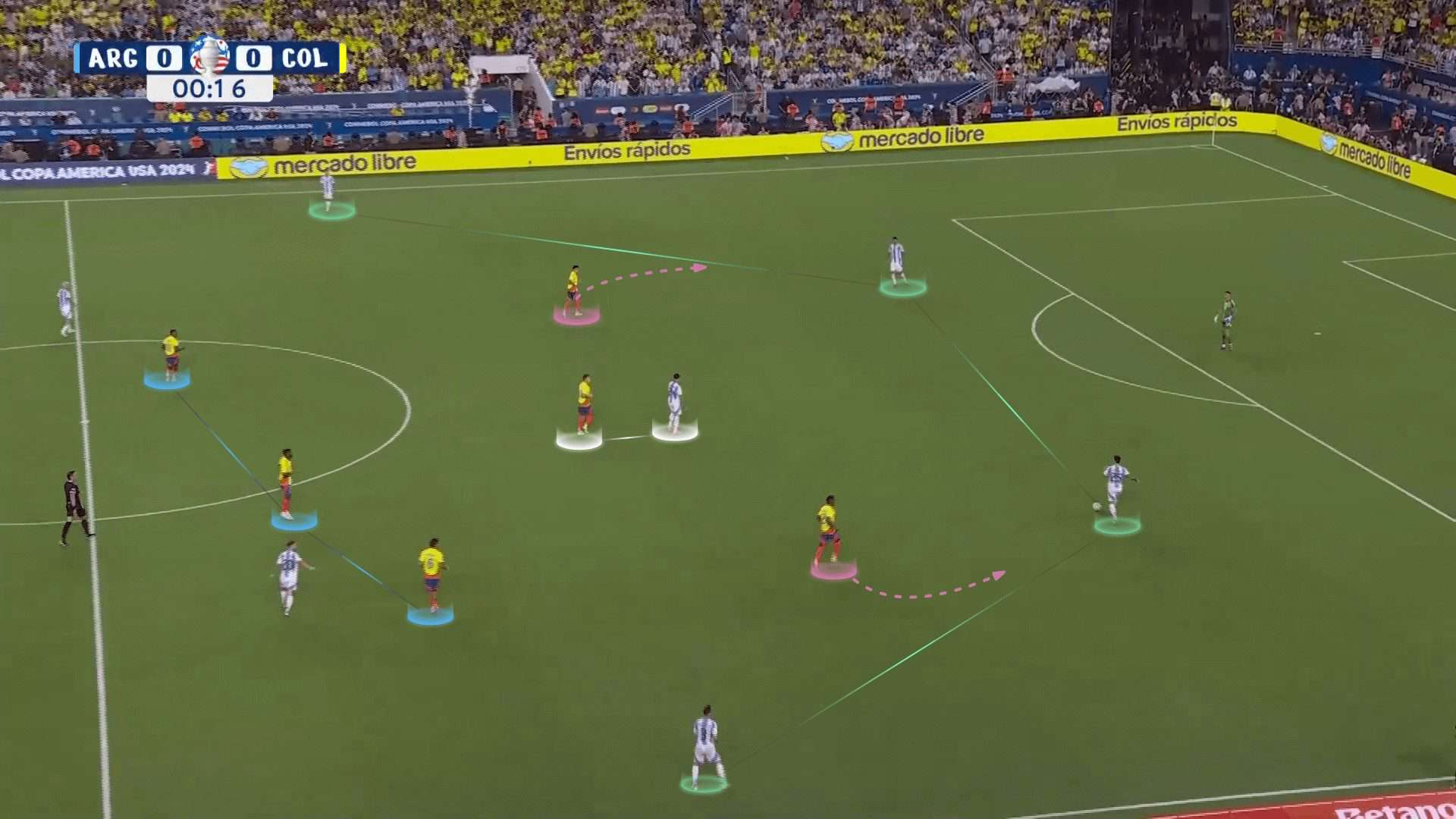
Colombia did not settle for this but rather intensified to the extent of demanding James to press the goalkeeper upon the ball’s return to him, effectively cutting the passing lane to the ‘6’ behind him by using the shadow-cover method.
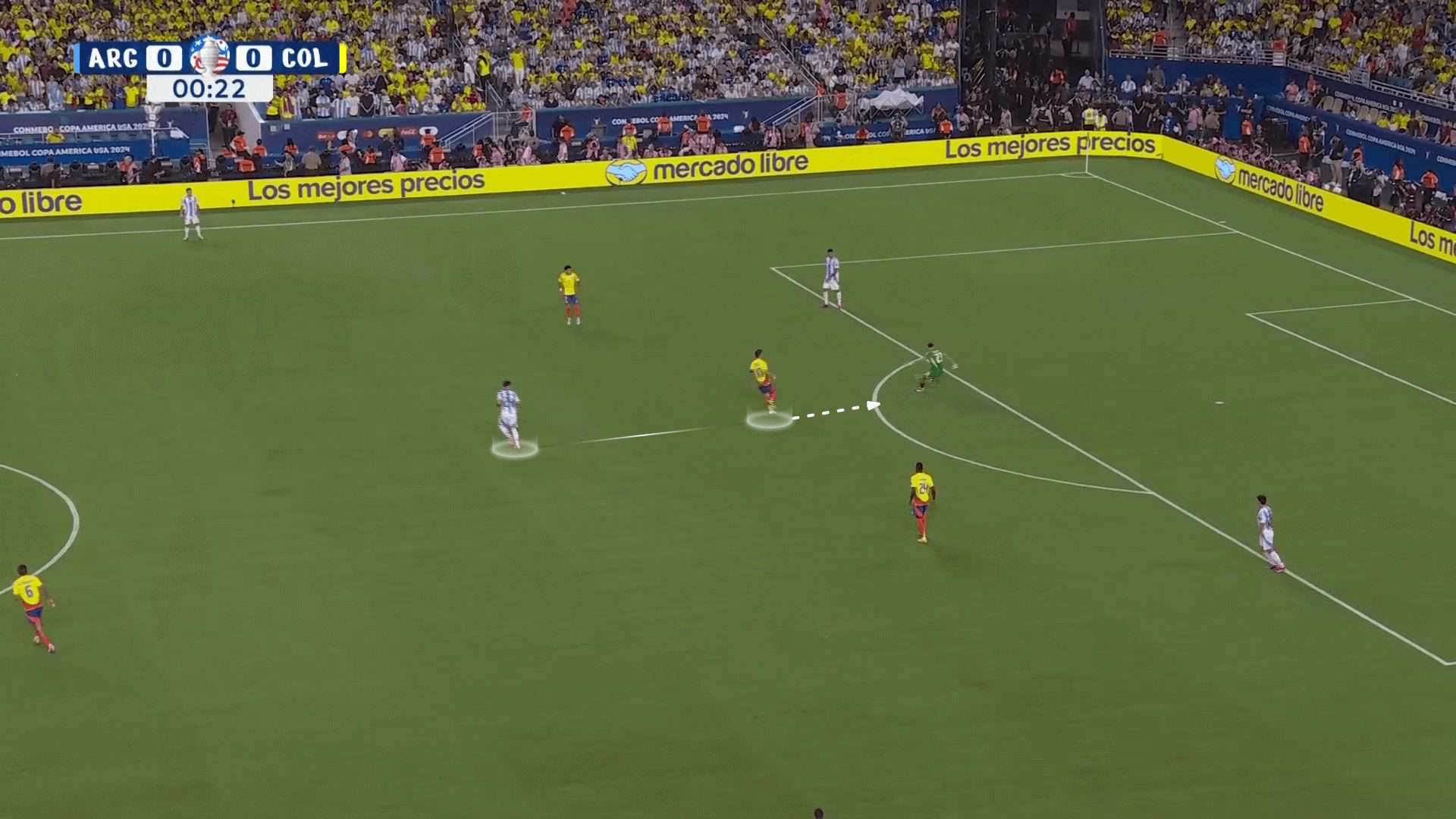
You may ask: What will happen if they pass the ball directly to a free-full-back? The answer is in the photo below.
The three midfielders have a shifting responsibility to keep one of them free because, as you see, Argentina sometimes use Messi as a false nine.
At the same time, Di María stands on the right flank and Álvarez stands on the left half-space to be near Messi and takes his position when he drops or drifts wide, so Colombia always want to have a free midfielder.
Coming back to our issue, The right midfielder (‘8’) goes to press the full-back while the other two shift, leaving the far Argentina’s midfielder free.
The right striker also chases him back to be ready for any delay in shifting.
In the end, Argentina are forced to get the ball back again, as in the second photo below.
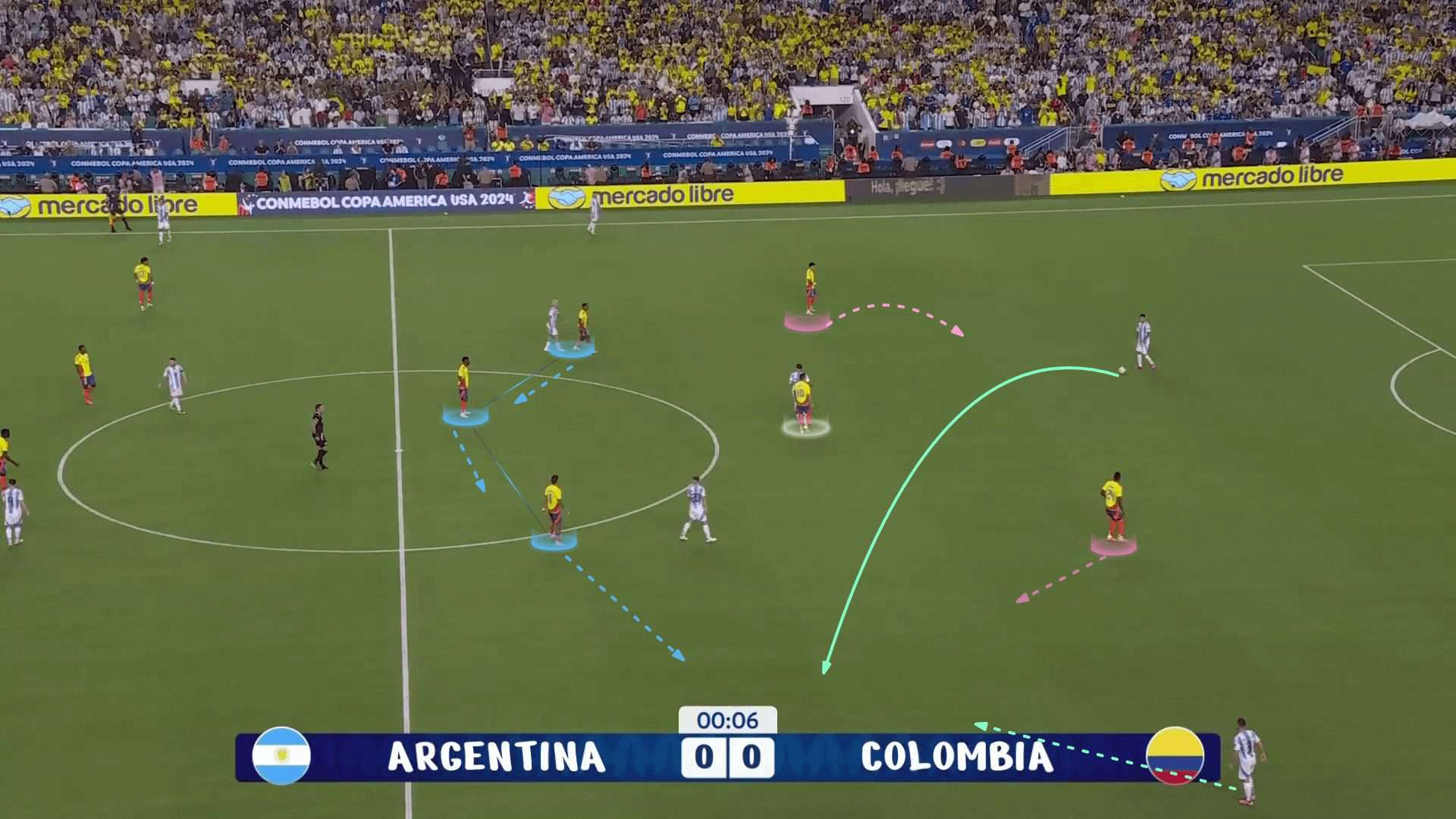
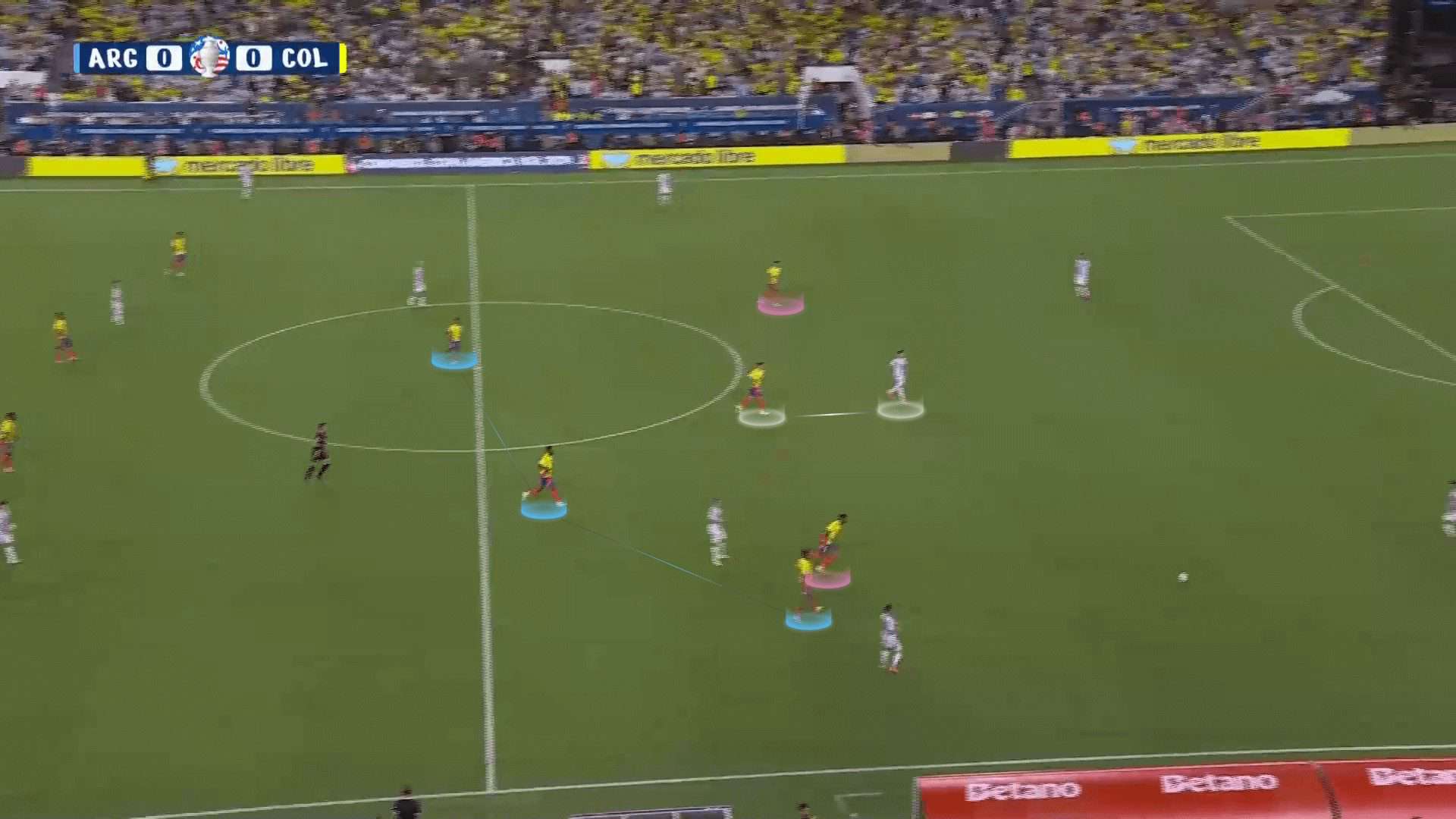
The one who presses the goalkeeper differs from the one who passes the ball back to him.
As you can see in the two photos below, the Colombian left striker continues to press the goalkeeper, which puts him in a difficult situation.
This is a chance to implement the side pressing there.
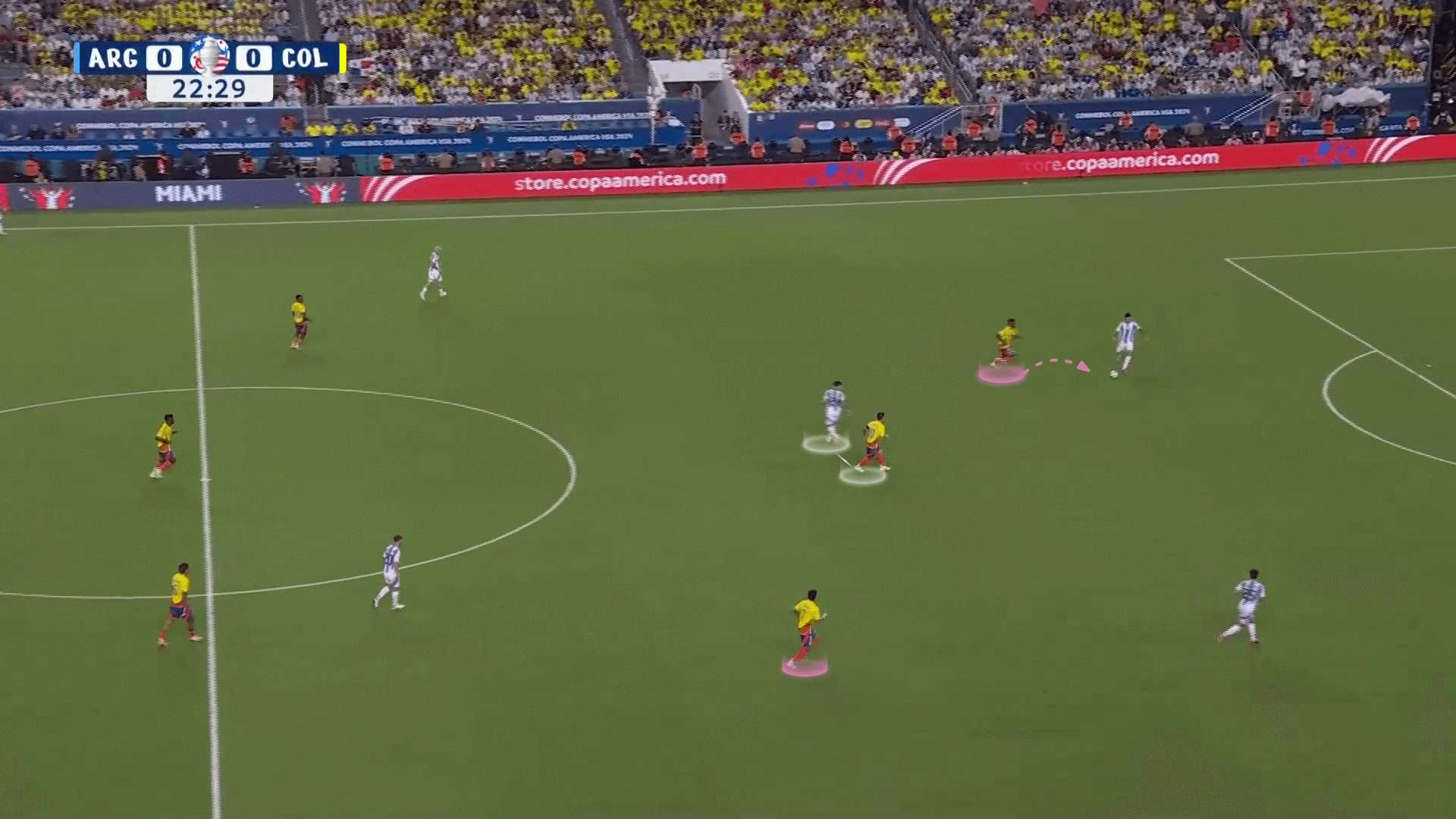
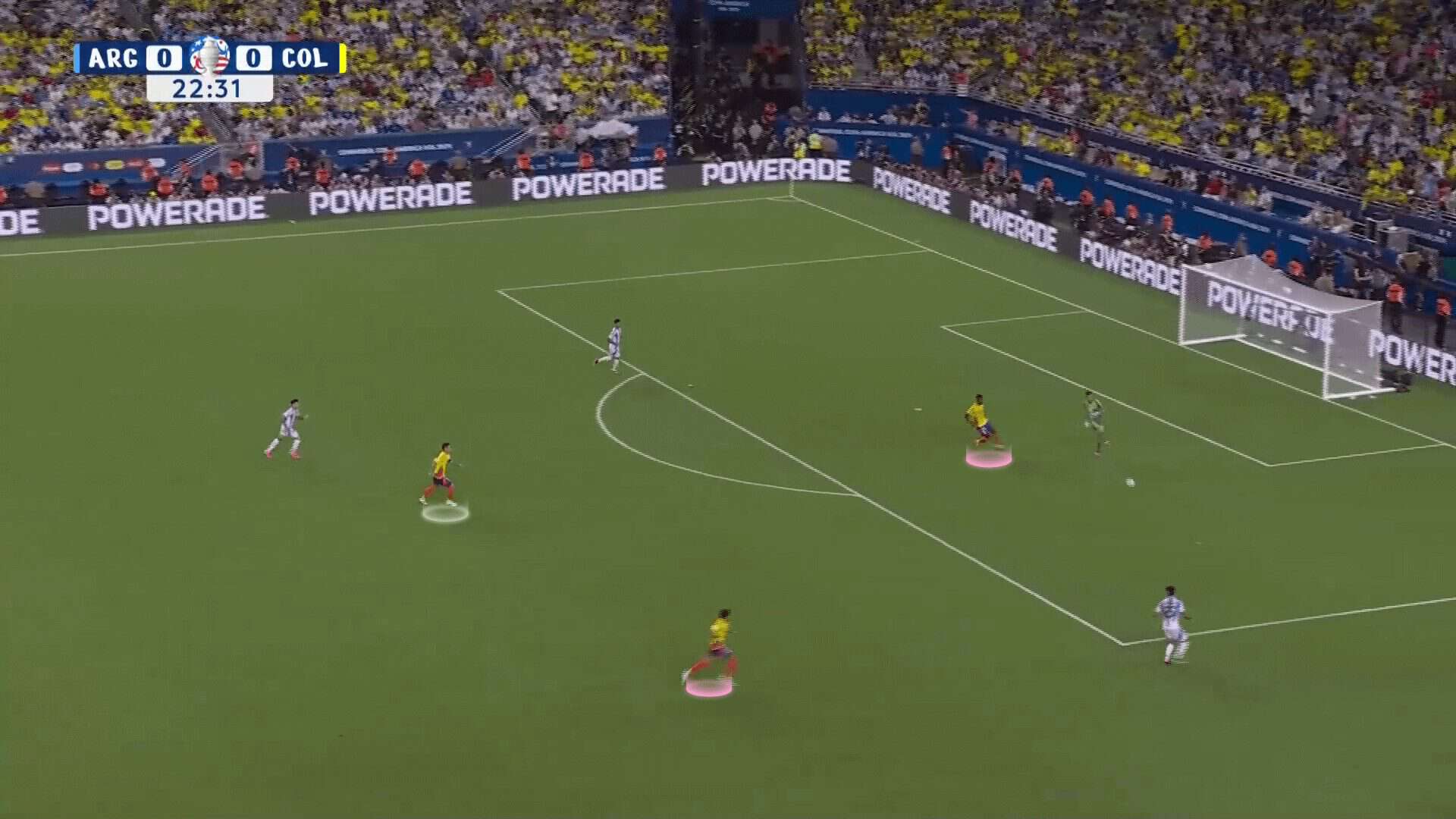
After that, Argentina’s goalkeeper, Emiliano Martínez, decides to send a long ball directly to a free full-back.
This is what Colombia want because the long ball takes a while in the air, enabling the three-midfielder to shift easily.
Also, because the distance is large, it is hard to send such an accurate long pass that enables the full-back to receive the ball, get it down, and continue the attack.
In the end, the ball goes to a throw-in, as in the two photos below.
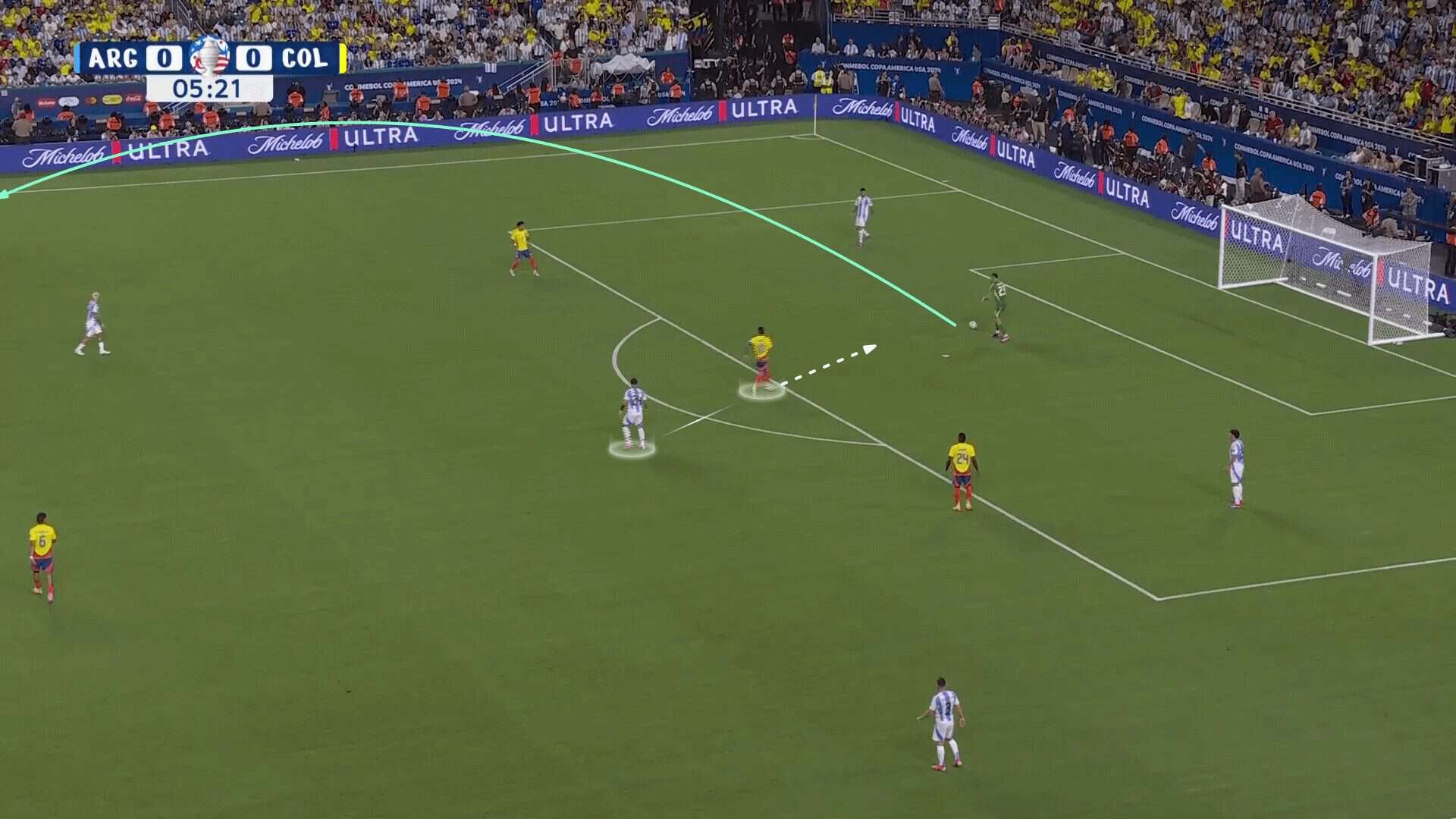
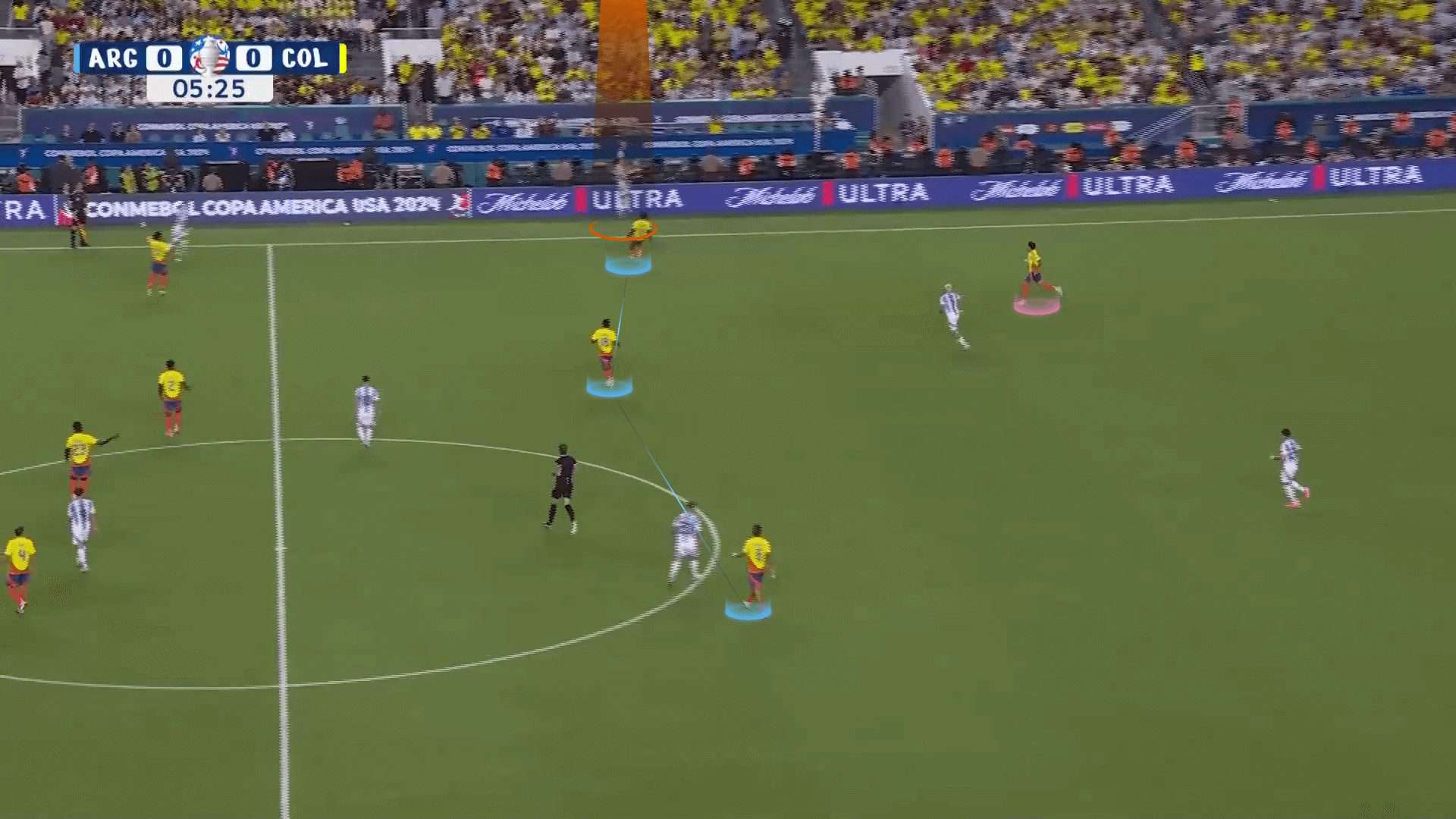
The time has come for the first variation, and the game of chess has begun.
De Paul drops to receive beside the Colombian left striker, so Enzo passes the ball to Romero, who passes the ball to De Paul.
It is as simple as that! Now you ask why can’t the left midfielder follow him as usual?
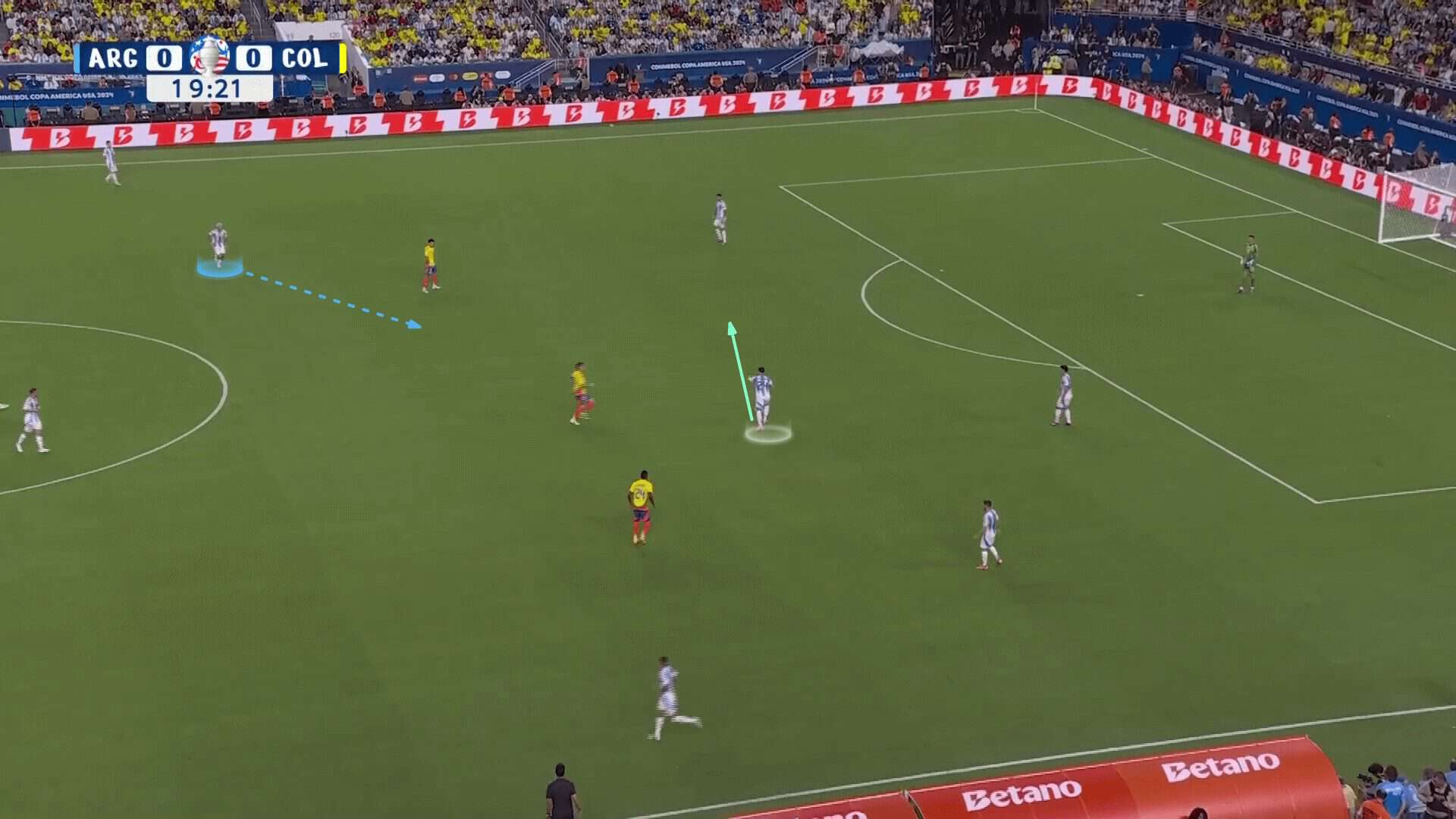
Here is the answer: The left midfielder hesitates because if he followed him, he would be so far from the full-back, who would be free, and the centre-back would pass the ball directly to him.
This time of hesitation enables De Paul to turn and dribble forward.
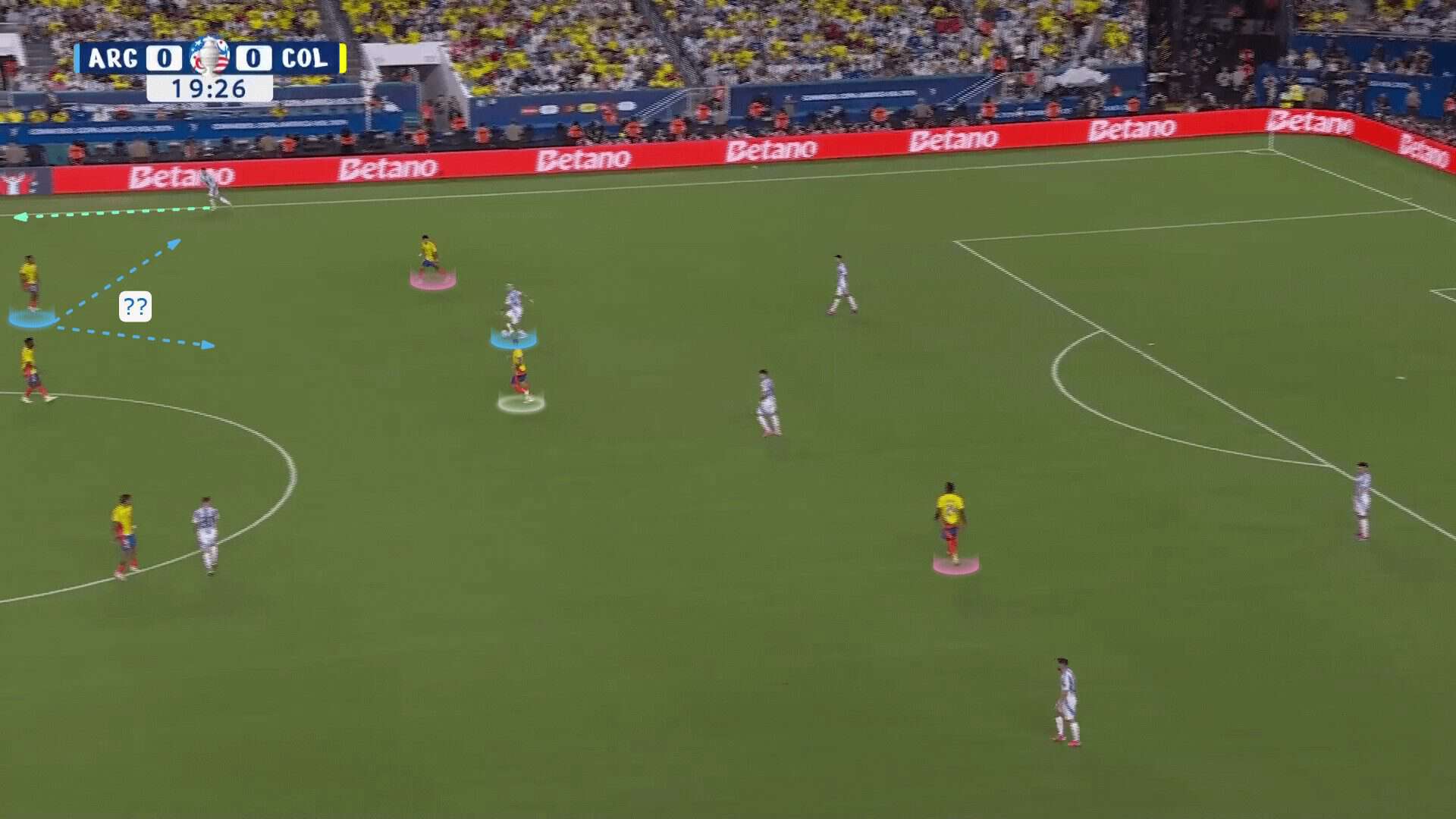
But don’t forget that they have an additional free midfielder, so they could deal with that issue without significant harm, as shown below.
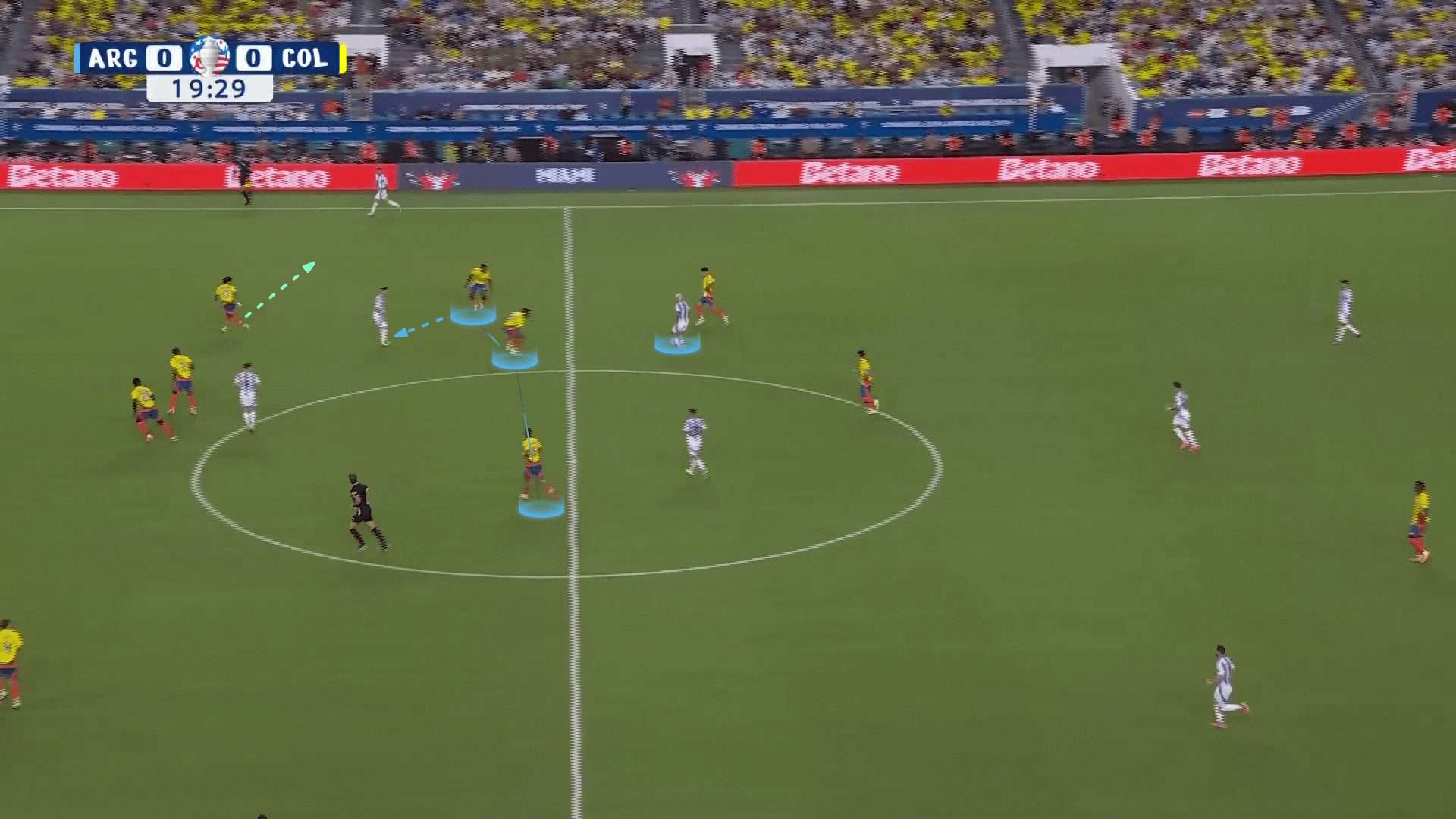
The second trick is Enzo dropping between the centre-backs, which gives him a better ability to pass the ball directly to the free full-back.
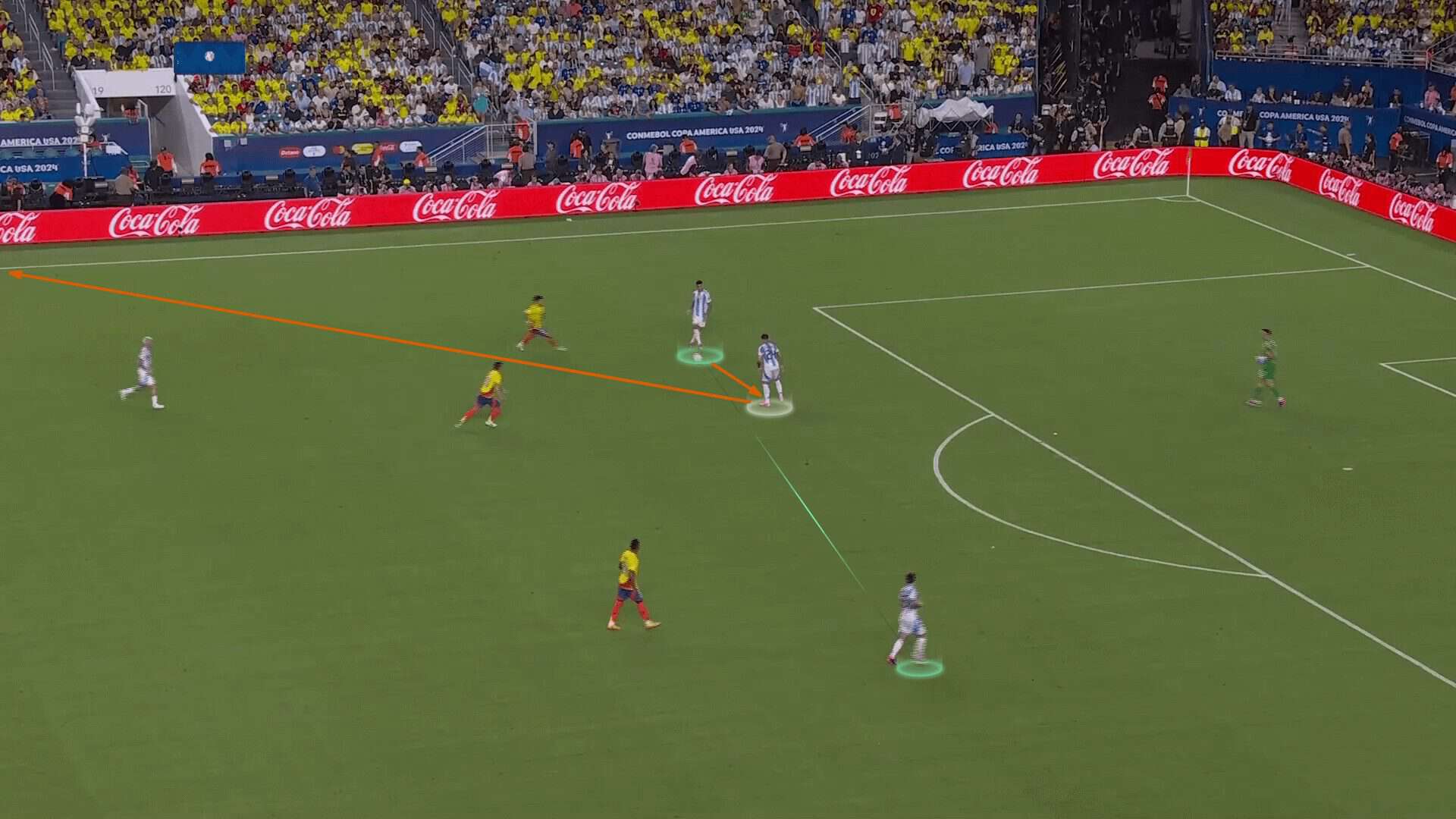
They worked on this idea, reaching the ball to a free full-back by many methods.
One of them is asking Mac Allister to drop suddenly and exploit his excellent ability to pass with his back to the pitch, so he makes a third-man pass to the running free-full-back from one touch, as shown below.
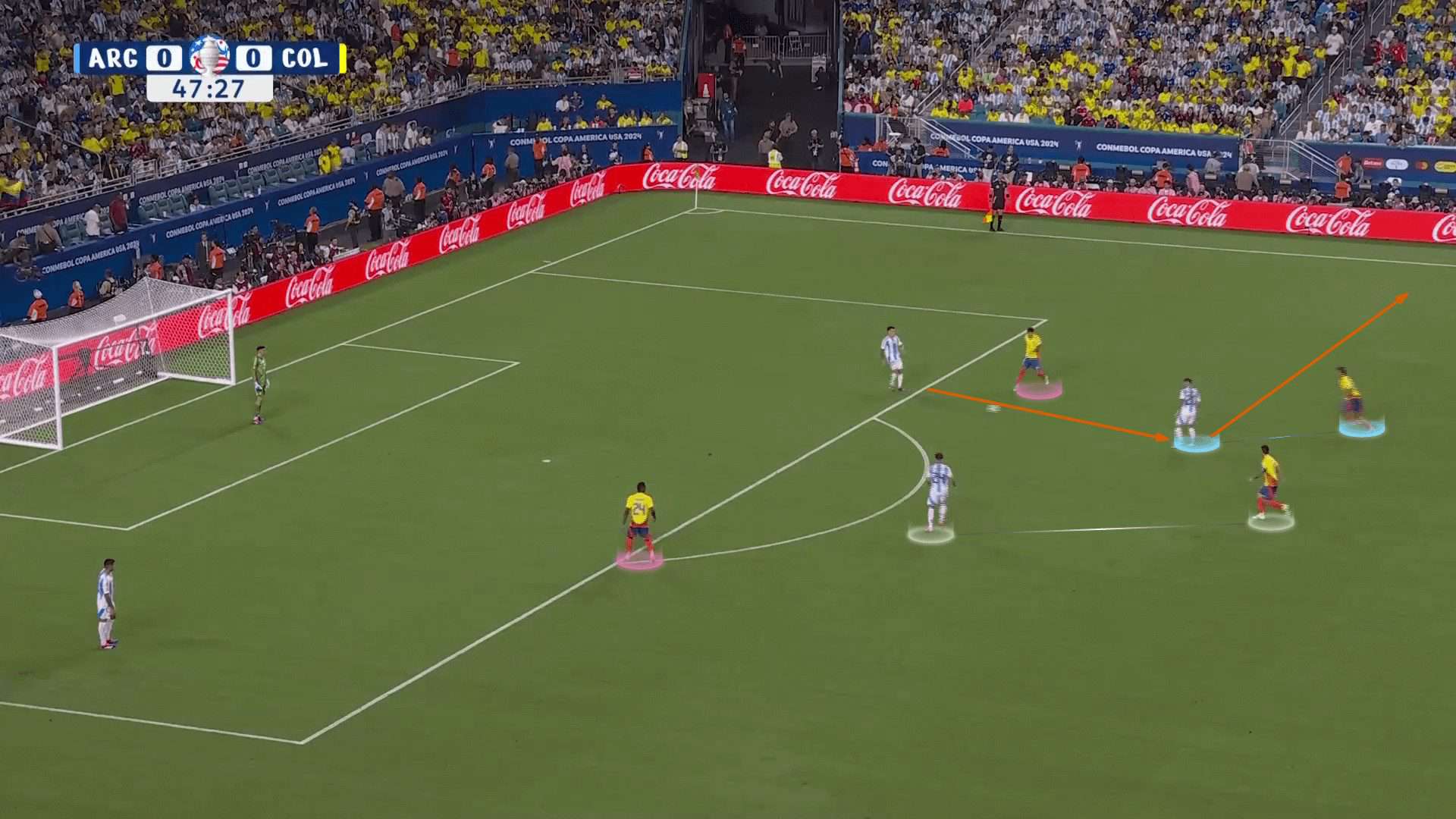
However, as we said, Colombia had a good shift toward the side of the ball, so it didn’t give Argentina a big advantage, as shown below.
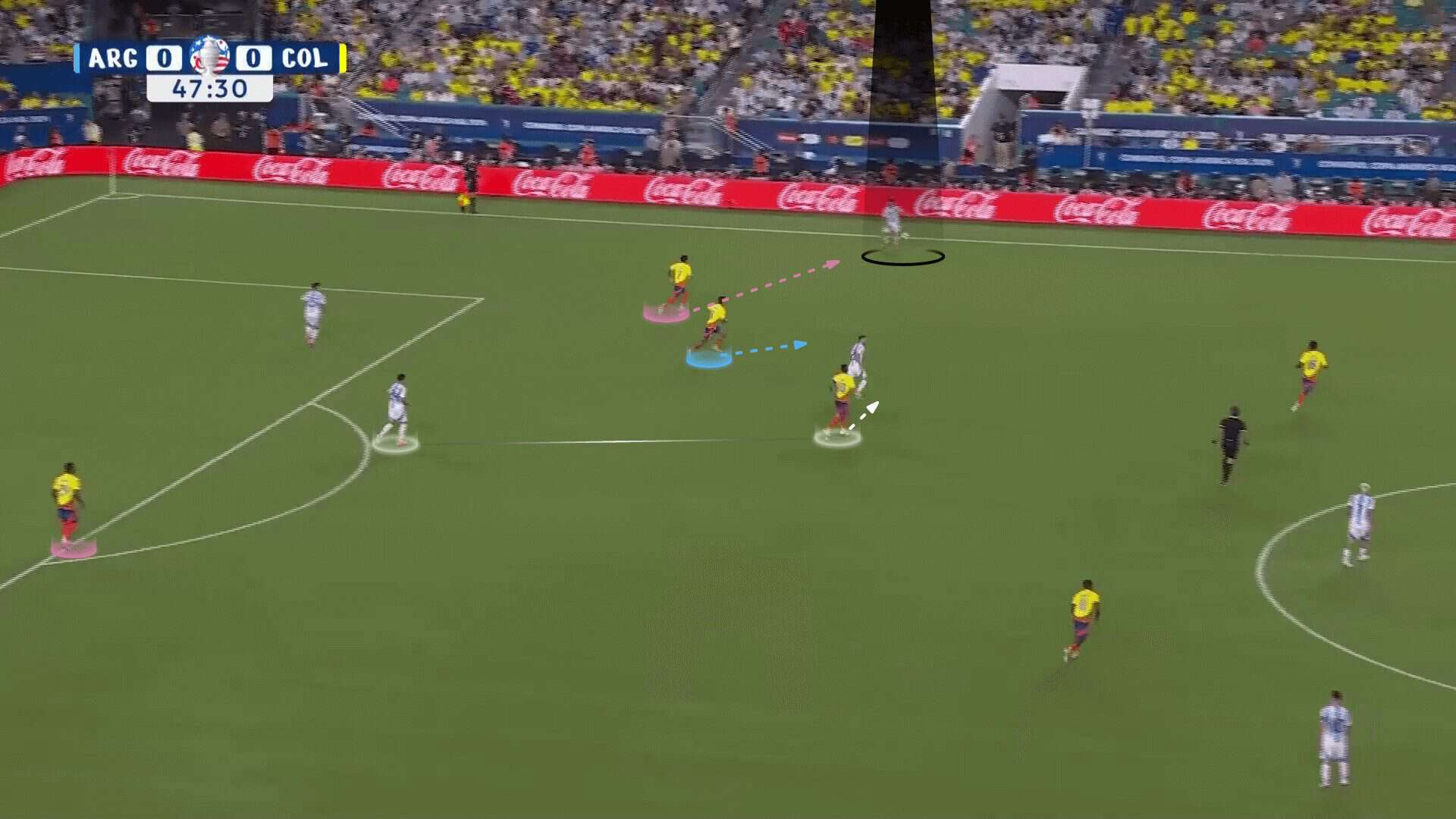
Argentina tried to work on that by using their joker, Messi, who dropped to the other side of the ball while the Colombian far ‘8’, De Paul, went towards the ball at the same time.
This posed a difficult question to the Colombian far ‘8’ during the complicated process of shifting: should he follow De Paul, leaving Messi free, or stand with Messi, leaving De Paul free?
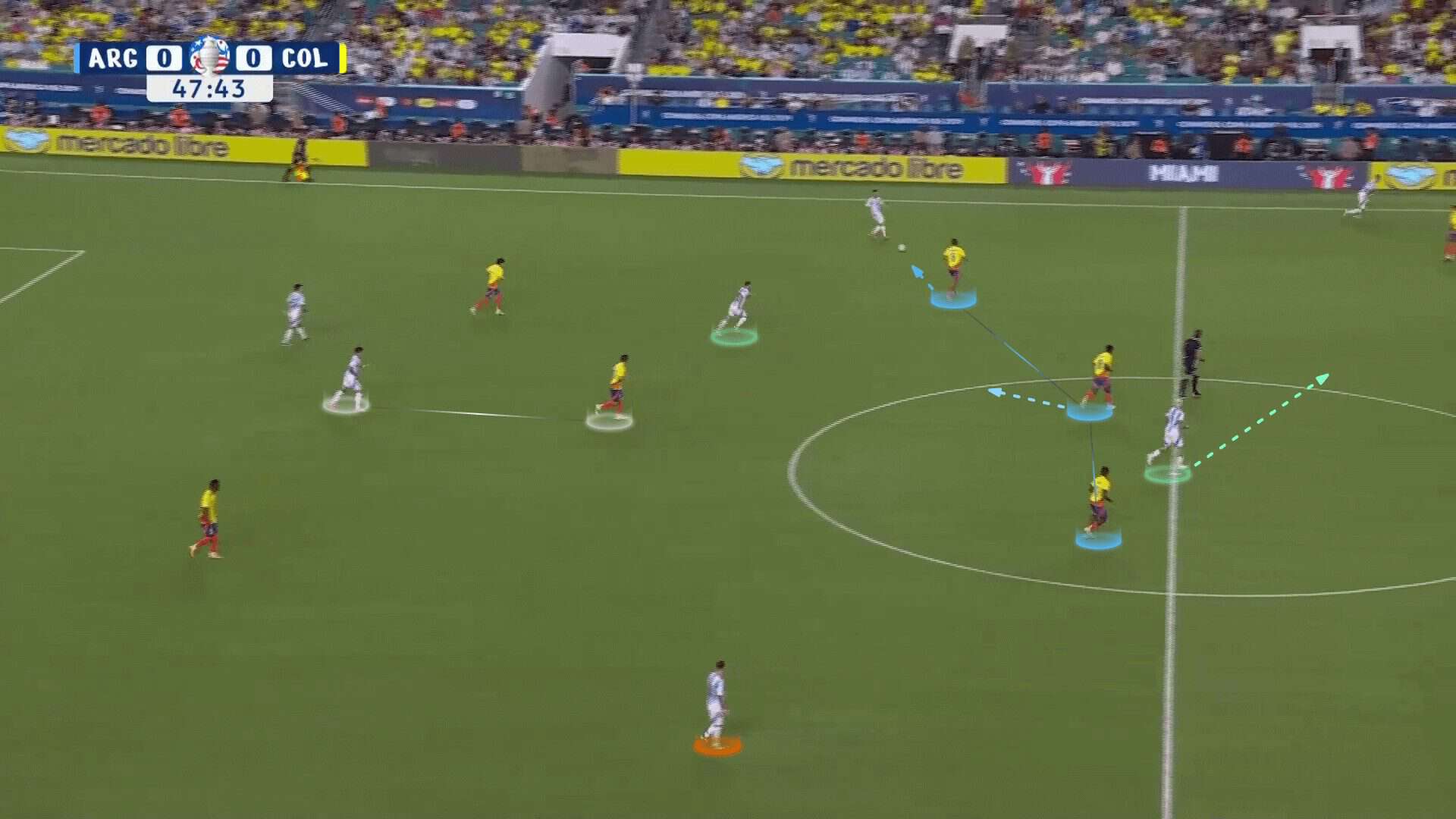
He was still in his hesitation until the ball reached Messi and Argentina could pass this tough phase.
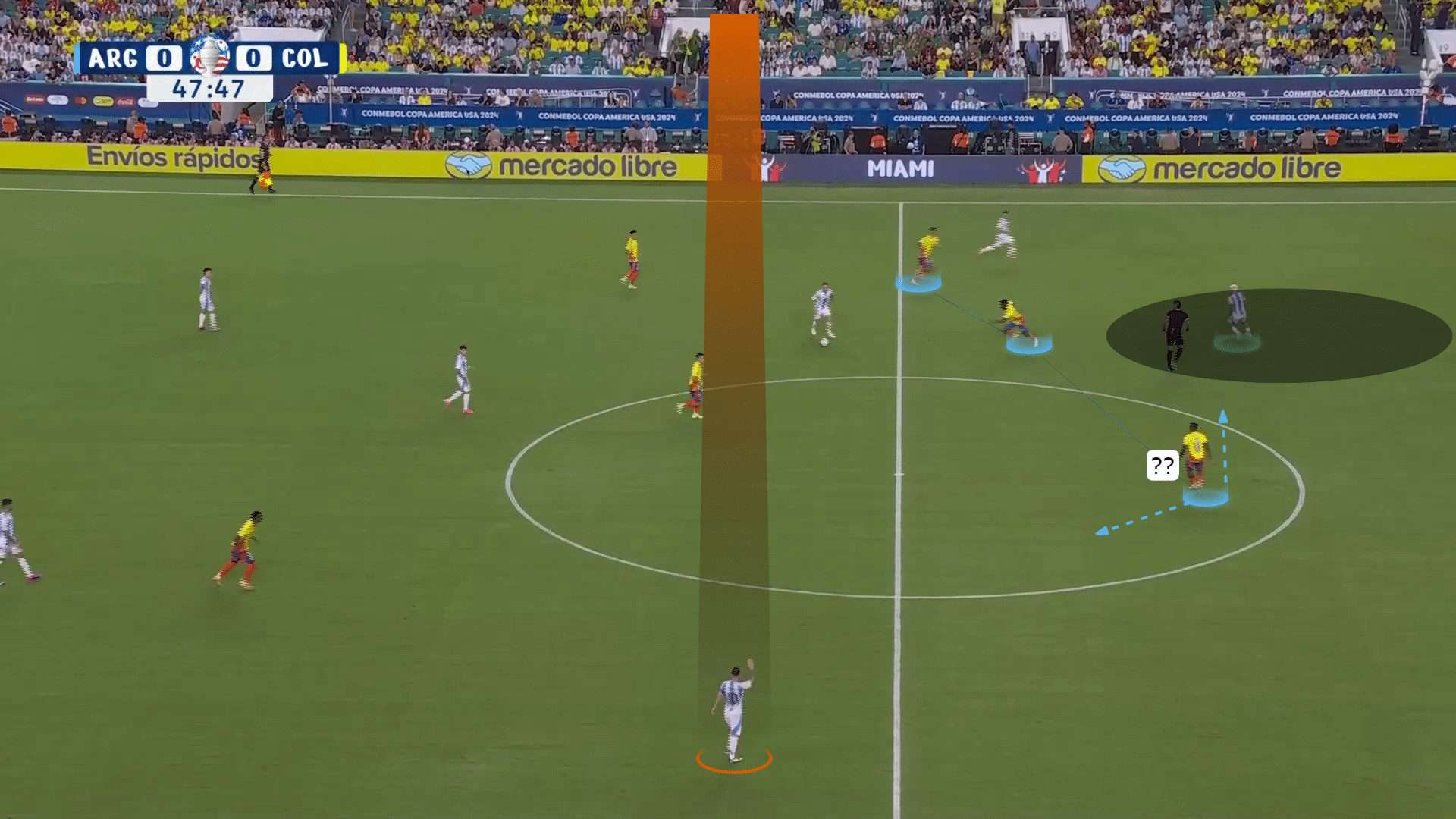
Colombia in possession vs Argentina out of possession
Lionel Scaloni’s side preferred the mid-press phase with a 4-4-2 shape against Colombia’s 4-3-3, asking Messi or Julián Álvarez to press a centre-back while the other presses the ‘6’.
Still, Messi can’t always do that shift, so usually, Álvarez tracks the ‘6’ while Messi stands with the centre-backs.
The priority is to ensure one of them is with the ‘6’.
As shown below, the midfield is a four-player line against three Colombian midfielders, leaving the two full-backs free at first too, so they also have a free midfielder, which is safer in general and against the player of the tournament, James Rodríguez, particularly who starts as a right winger, but so free.
When the ball gets to the right full-back, the shift happens, asking the far midfielder, Ángel Di María, in this case, to mark the far midfielder, leaving the full-back free.
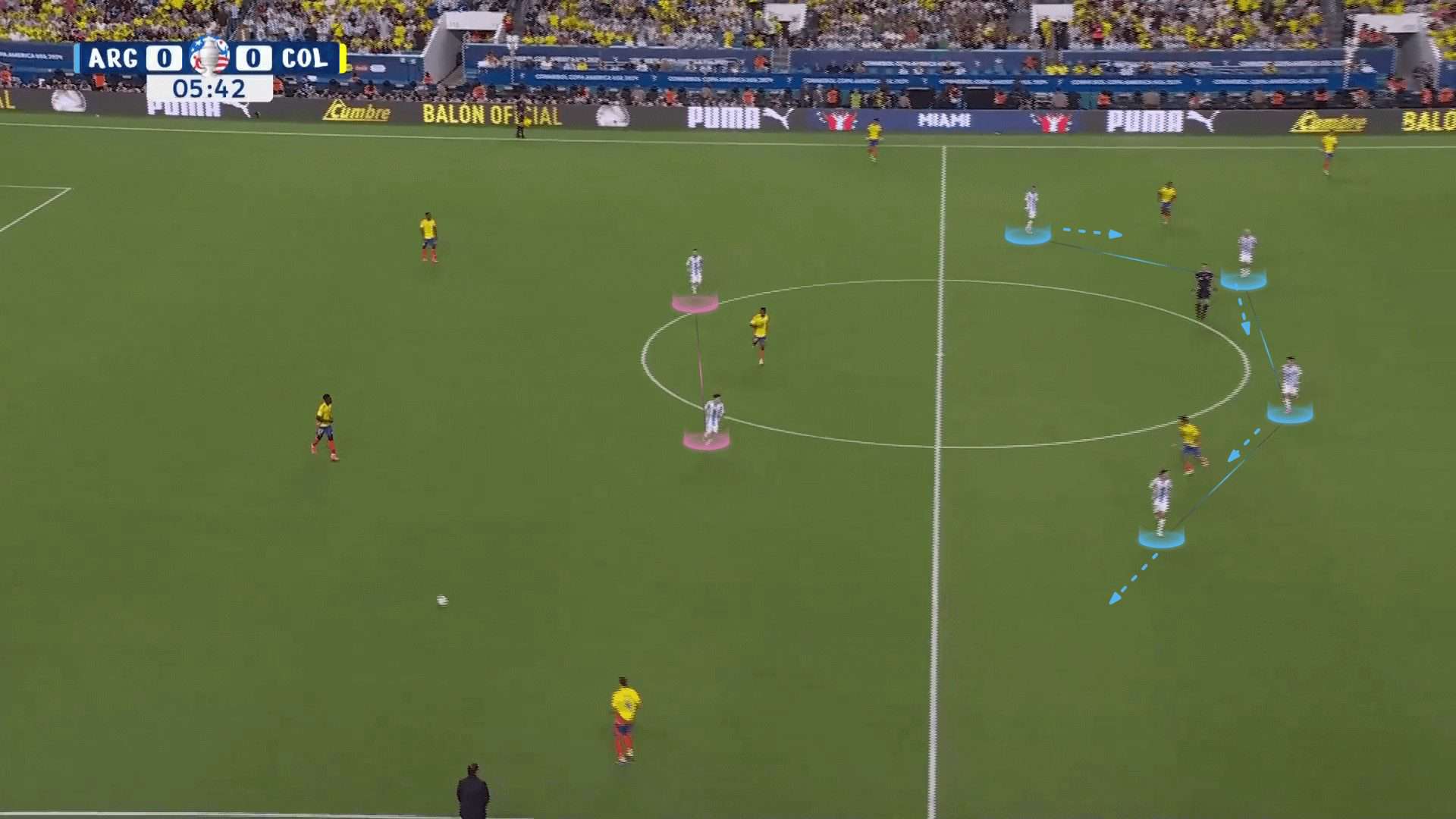
Colombia always gives freedom to their attacking weapon, James Rodríguez, who drops to receive and turn facing the pitch with open view, as shown below, and you can notice that the left full-back doesn’t follow him warning his mates.
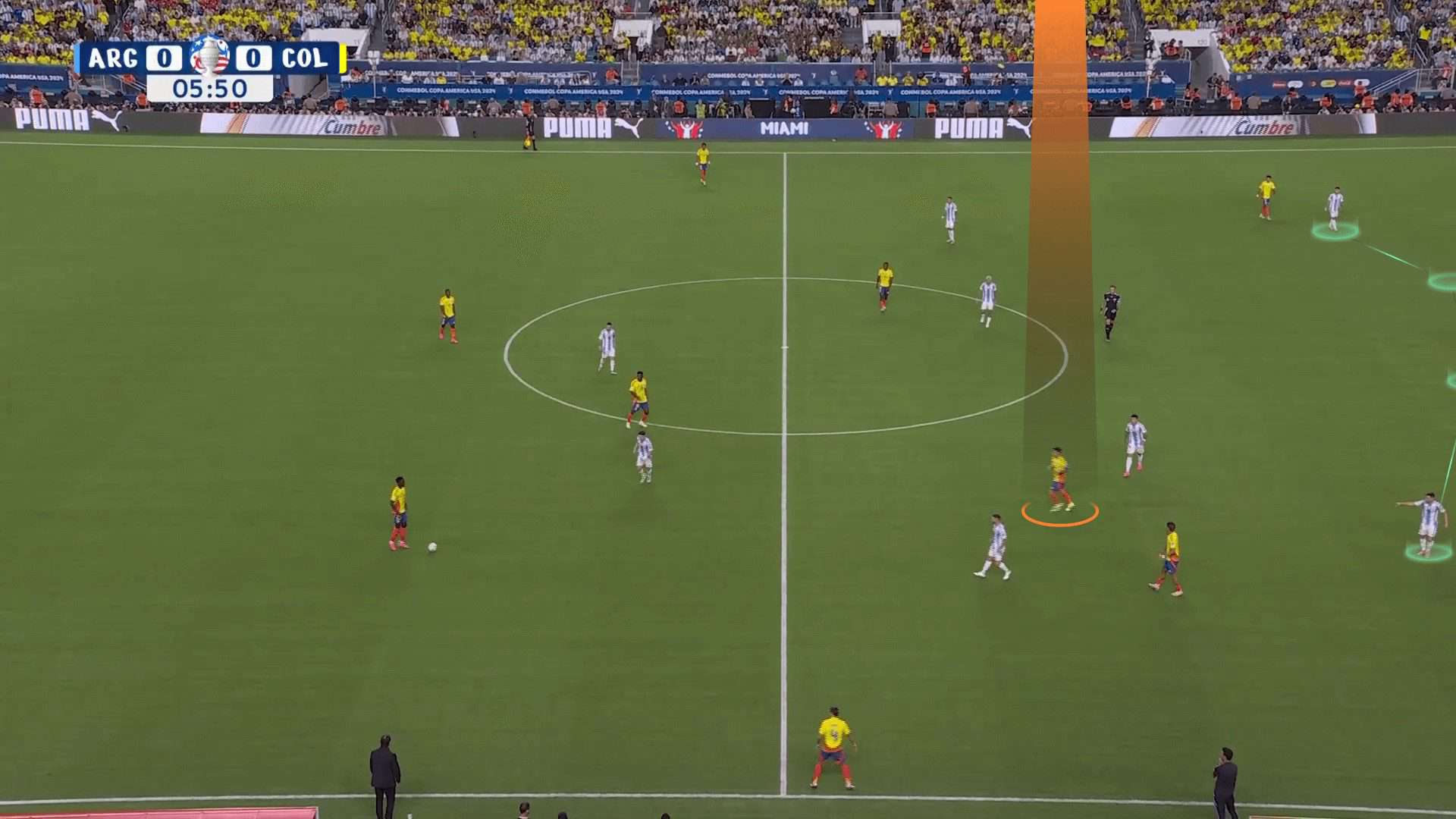
As we have mentioned, Álvarez is the one who does the exhausting missions, so he comes back to press him to make everyone still stand in the supposed position while Messi shifts to the ‘6’, so it usually ended with no threat except that James sent some dangerous long balls.

But Messi can’t, physically, always do that shift, so Álvarez leaves the ‘6’ free, as shown below.
At the same time, the other winger, Luis Díaz, has also the freedom to cut nearer ready to move behind the midfield line.
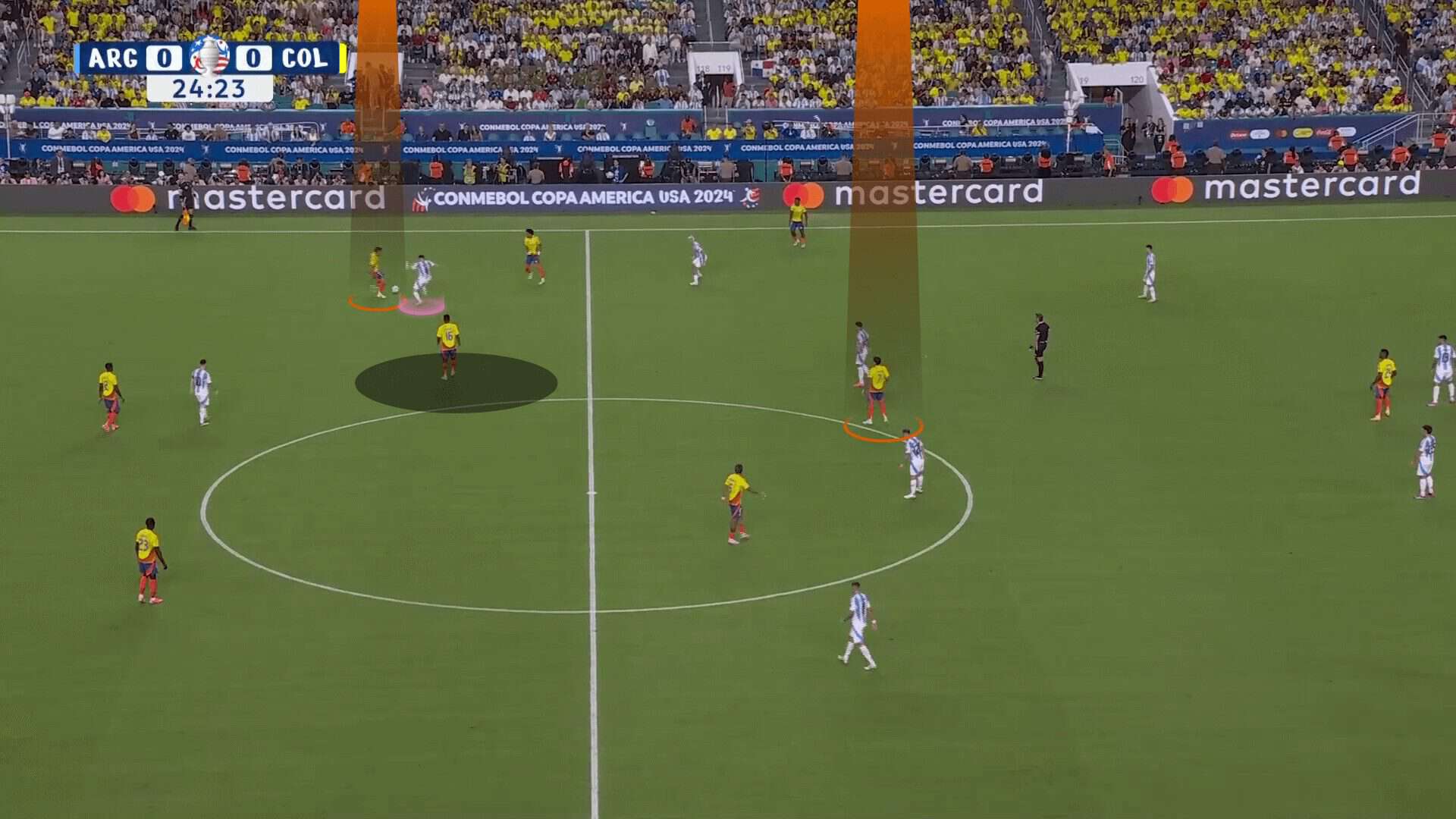
James brilliantly passes the ball to the left midfielder, who touches the ball to the free ‘6’, while Díaz is ready to receive behind the midfielder, who pushes up to press.
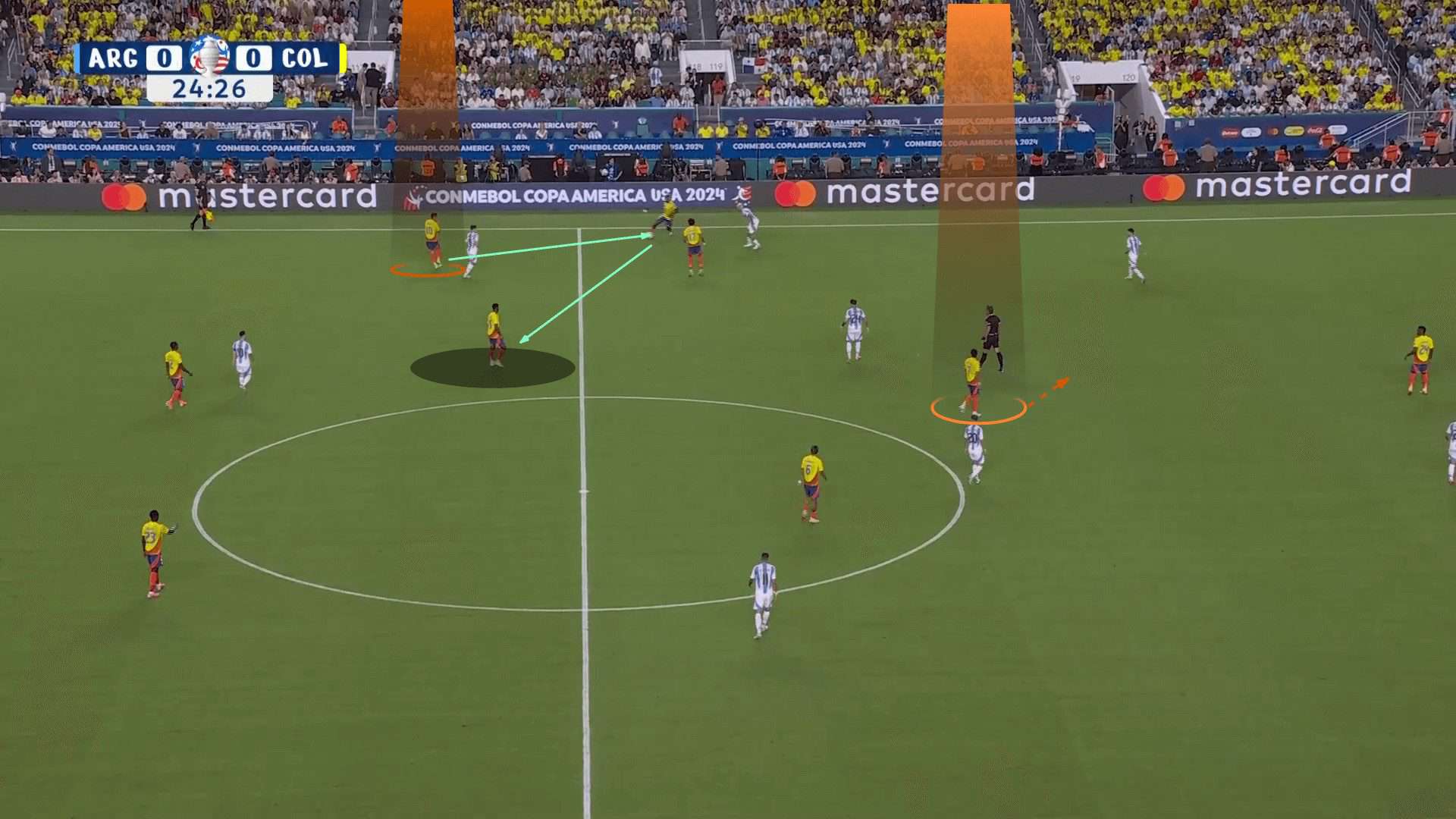
Even in attacking transitions, James Rodríguez and Liverpool‘s star, Luis Díaz, were given the permission to feel free, James dropped to receive while Díaz moved freely toward him behind the midfield line to receive while the striker tried to fix the defence line.
In the first photo below, the ball is cut from Argentina while their three forwards are still falling back, so James drops to receive the ball while Díaz moves toward him.
After that, they have the freedom to get closed and do a double pass.
Then, James crosses the ball from a frontal to the goal and near position, which he loves, while the far full-back and the far ‘8’ go into the box, which leads to a dangerous chance, as in the remaining photos.
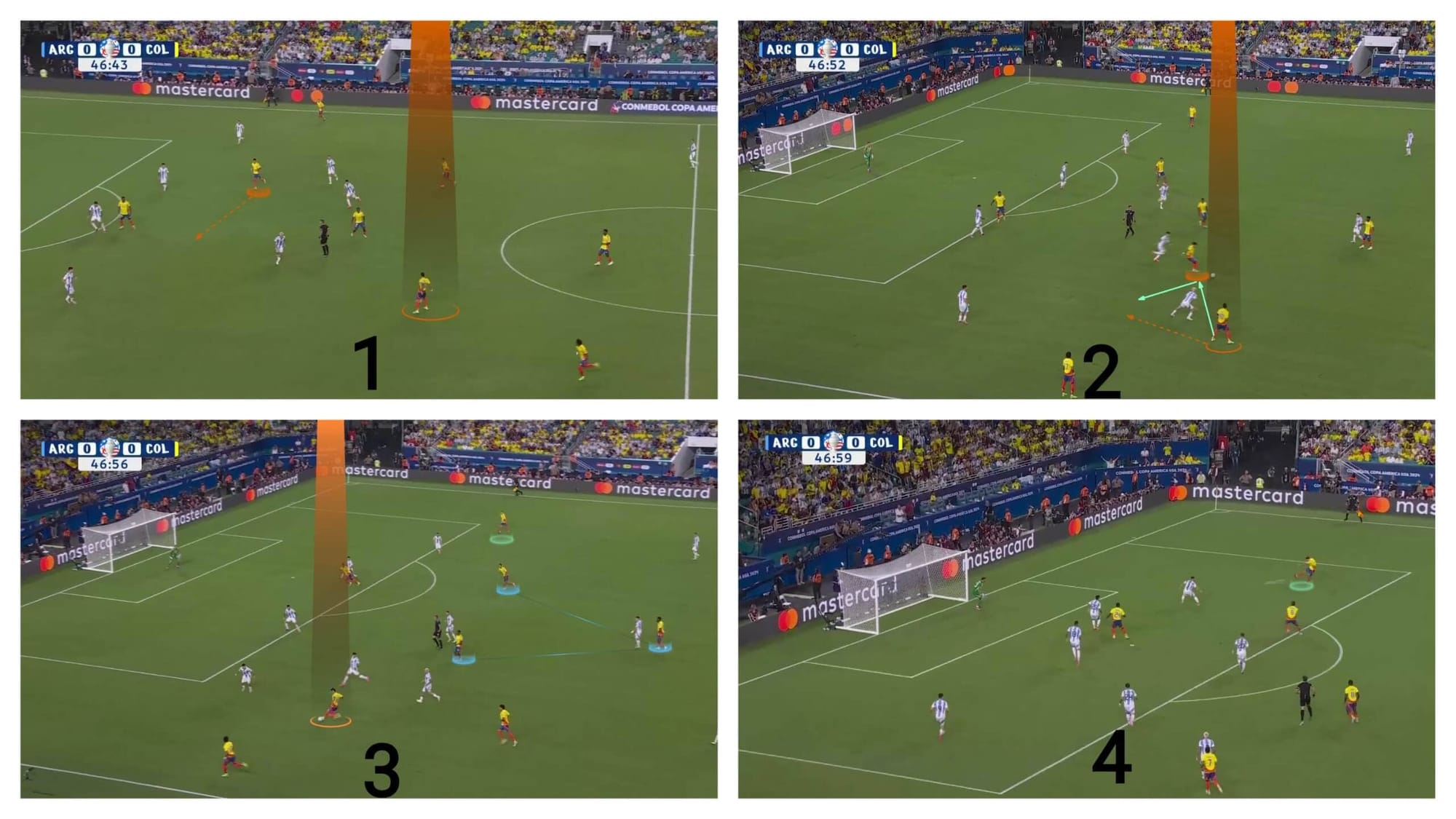
After that, they were asked to drop more in the organised phase, the final third.
They both took the positions of the two ‘8’ who stood freely behind the midfielders, exploiting the moment they decided to press the ball holder, as in the photo below.
However, Lisandro Martínez bravely was ready to chase the ball receiver while the left winger was ready to help into the middle, so they couldn’t make the best use of this trick.
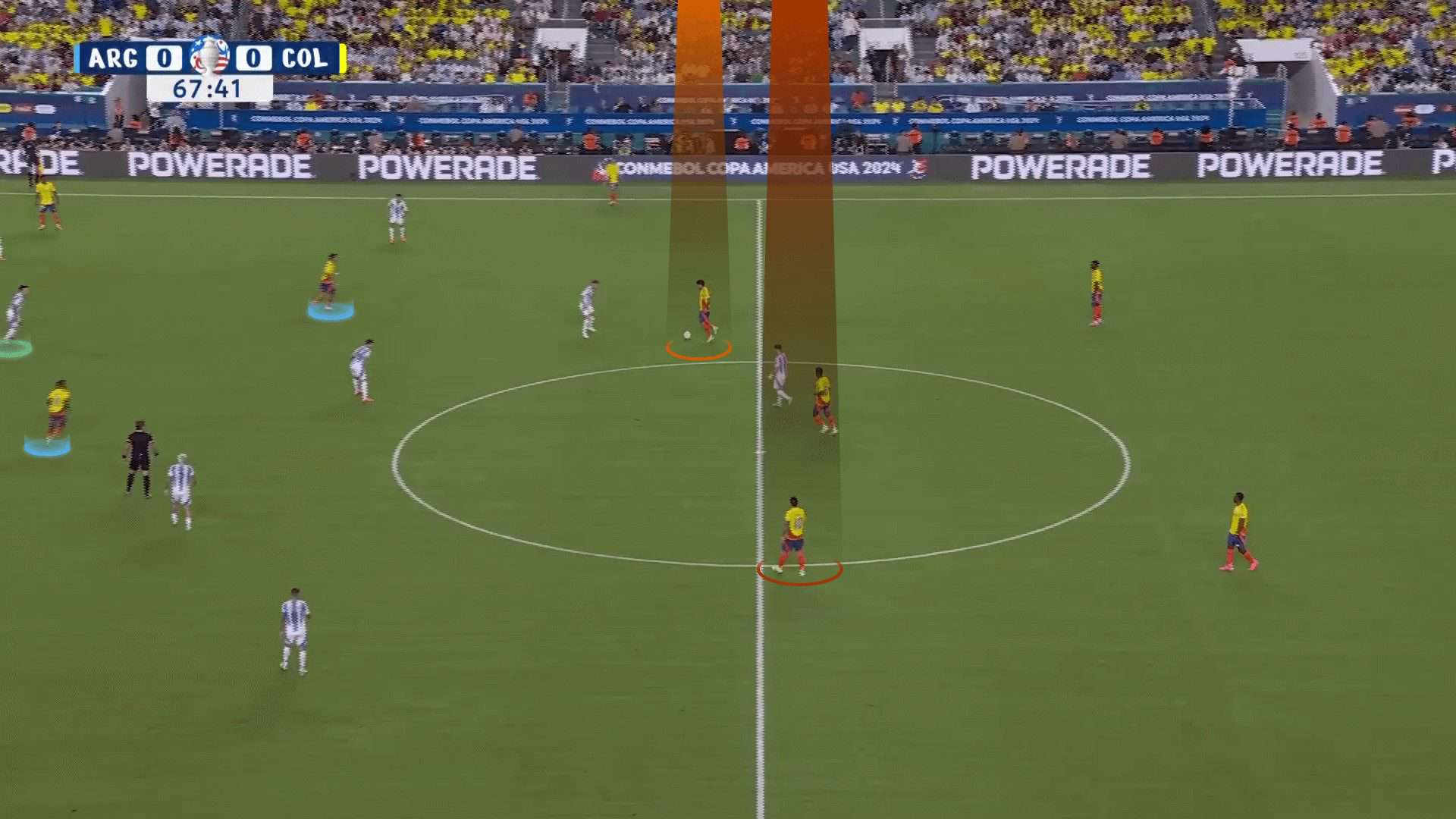
Conclusion
In this analysis, we have explained why the final of Copa América 2024 lasted for 120 to be determined and how the chess game between the coaches led to a 0-0 result for nearly 112 minutes.
In addition, we have illustrated all the tactical trials of each team to get through the opponent’s defensive block, the high-press scheme of Colombia and the mid and low-press scheme of Argentina for most of the game.






Comments